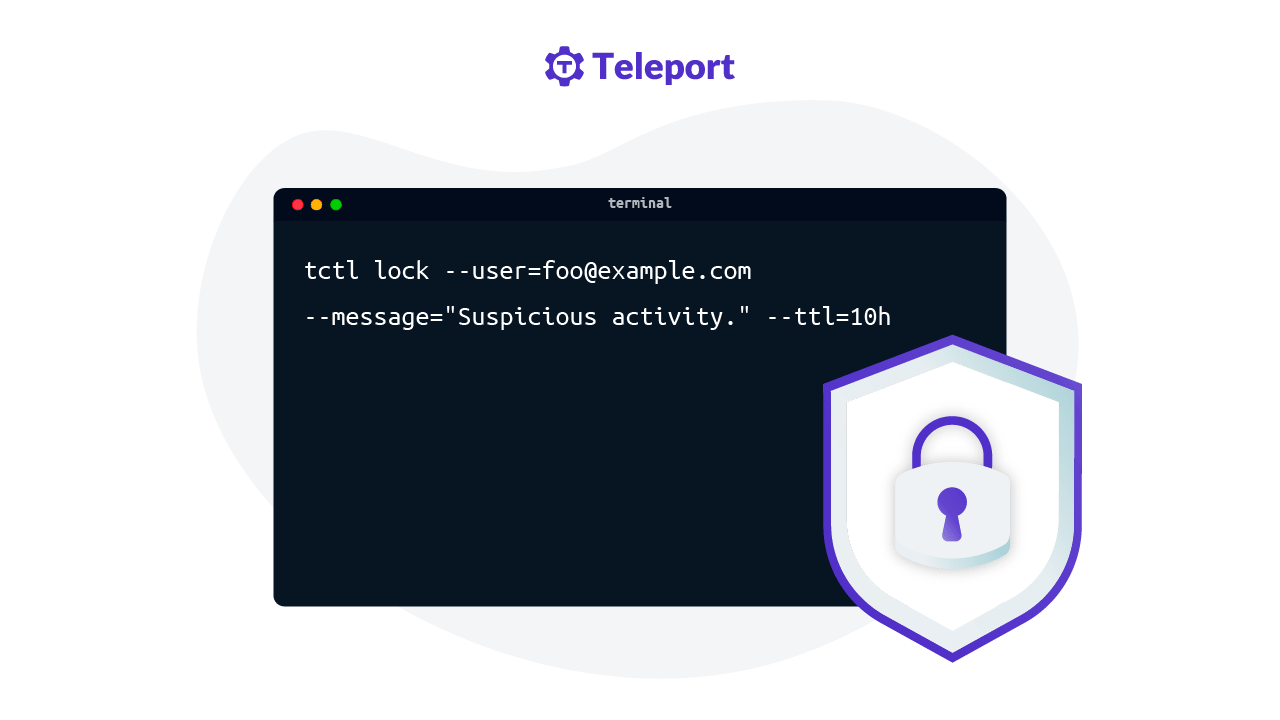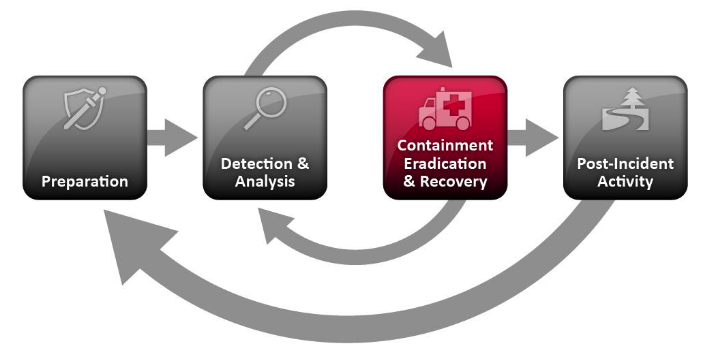Home - Teleport Blog - Security Incident Containment with Teleport Session and Identity Locking - Sep 10, 2021
Security Incident Containment with Teleport Session and Identity Locking

What would you do when a security incident is detected? Shut down the servers? Pull out the power cord from the data center? When an incident is detected, both the incident method and the time required to contain an incident are essential to limit the damage. The slower you are to react, the more damage an incident would incur. And a service downtime to contain an incident can cost businesses even more than a security incident itself.
There have been advances in Security Orchestration, Automation, and Response (SOAR) platforms and Automated Incident Response tools that offer incident-specific playbooks and response automation tools for easy and systematic incident containment. However, their capabilities depend on containment features and automation API (or CLI tools) offered by infrastructure and security products. Additionally, the silos in cybersecurity products make it more challenging to automate coordinated incident containment.
We’ve worked with teams to help solve these problems, and with Teleport 7.0, we are thrilled to announce that we’re one step closer to better SOAR with Teleport. Teleport 7.1 includes a Session and Identity Locking feature that allows rapid containment for incidents involving compromised access.
Introducing Session and Identity Locking with Teleport 7.1
Teleport 7.1 brings a Session and Identity Locking feature that suspends all active and future interactions like SSH/DB/k8s connections and certificate requests matched by the lock's target.
A lock can target the following objects or attributes:
- A Teleport user by the user's name;
- A Teleport RBAC role by the role's name;
- An MFA device by the device's UUID;
- An OS/UNIX login;
- A Teleport node by the node's UUID (effectively unregistering it from the cluster).
Upgrade to Teleport 7.1 today to fully enforce the locks at all components. Refer to this guide on Session Locking that describes the feature and usage in detail.
What is Security Incident Containment anyway?
Incident containment is one of the most critical aspects of a security incident response handling process. A fast and coordinated containment strategy can significantly limit the damage in a security incident.
Following NIST's computer security incident response handling guide, a typical security incident handling process involves four phases:
- Phase 1 - Preparations. Building incident handling capability with people, process, and technology.
- Phase 2 - Detection and Analysis. Identifying if a security event is a security incident. At this step, you also identify the state of an incident. E.g., is this an active incident? Is this an indication of a breach that happened in the past?
- Phase 3 - Containment, Eradication, and Recovery. Stop the threat actor (malware or human adversaries) from causing further infection or lateral movements (pivoting and propagating in the network).
- Phase 4 - Post-Incident Activities. Lesson learned and re-invest in step one, i.e., Preparations.


The incident containment process depends on the type of incident. For example, a DDOS incident containment strategy can be different from a malware infection or compromised access incident. Incident containment can be further classified into two categories:
Short-term containment Short-term containment is the quickest patch you can apply without a concrete plan (instant response to the incident). Examples include:
- Applying a monkey patch to change the runtime behavior of a compromised application
- Isolation of compromised networks
- Shutting down production servers
Long-term containment A well-planned temporary fix to contain the incident. A long-term containment is a strategy to bring back infected systems online by rewriting security policies and altering networks or systems so that the vulnerabilities or misconfigurations that were exploited are addressed.
How does the Session and Identity Locking feature help with Incident Containment?
As an Access Platform, Teleport has features that can be used to quickly contain lateral movements and prevent further infection propagation due to compromised access. Lateral movement is a popular adversary tactic in a security incident lifecycle (see MITRE ATT&CK matrix). After initial credential compromise, the next step for adversaries is to further pivot inside the network, escalate privilege, compromise further systems, maintain access, and ultimately exfiltrate data.
Below are a few instant benefits of using Teleport for containing compromised access incidents:
Live patching
One of the best short-term containment strategies is the ability to patch malicious access at runtime without service downtime. With Teleport, you can block access (including already authenticated active sessions) at runtime. No service restarts or extra tooling are required to lock a session.
Revoking trusted access
One of the problems in a certificate and signature-based authentication like JWT or even Teleport certificate auth is certificate revocation. Once a certificate is issued, revoking trust is hard. With Session Locking, invalidating signed and trusted certificates is possible since locking is enforced at the session-level. This can be a handy control to contain incidents involving an insider threat.
Control over containment duration
During the Detection and Analysis Phase of incident response, incident handlers need to apply a quick patch (short-term containment) before additional information is identified. A full access revocation of a user who might not be a threat actor can be a waste of administrative time. Teleport Session Locking allows supplying duration of the lock so that you can block access for a short duration (e.g., block for one hour) so that if a user is later flagged as a non-threat actor, they can continue with their operations after the blocked period without the need of full access reassignment.
Identity-based locking
Only lock malicious user access. Together, identity-based locking and live patching are probably the most significant advantages of the Teleport Session Locking feature. In a typical incident response scenario, a short-term containment strategy is usually performed by shutting down the production servers and blocking all connections, resulting in service downtime. We mentioned earlier that service downtime can cause business more damage than a security breach itself. On average, a cost of downtime can cost a business as much as $9000 per minute. Therefore, avoiding service downtime is probably one of the biggest challenges in short-term incident containment strategy, and Teleport's Session Locking feature helps to avoid this.
Evidence preservation
Apart from service downtime, another risk to the short-term incident containment process is losing the evidence. When a server or network is quickly decommissioned to respond to a security incident, you risk losing evidence along with it. Teleport's session recording feature can help preserve access and session evidence even if a hard reset is applied to the infected server or network.
Easy to integrate with SOAR platforms or incident response playbook
Teleport's first-class support for API and CLI tool (tctl) makes it super easy to integrate with SOAR platforms. For example, you can add the following command to your SOAR platform or response playbook to automate access blocking in case of a security incident.
$ tctl lock [email protected] --message="Suspicious activity,locking user for 10hrs." --ttl=10h
Teleport cybersecurity blog posts and tech news
Every other week we'll send a newsletter with the latest cybersecurity news and Teleport updates.
The Access Platform advantage
When your infrastructure access is managed by a single service offering a uniform layer (only one way in and one way out), it becomes super easy to contain a threat. Teleport's existing features, such as Enhanced Session Recording with BPF (Berkeley Packet Filters), are already a powerful tool for security auditors and incident handlers. With the release of the Session and Identity Locking feature, we are empowering incident handlers with both incident containment and post-incident analysis capabilities to respond better with compromised access.
What’s next?
With each new Teleport release, we are bridging the gap between operations and security requirements. Stay tuned, support for Hardware Security Modules (HSM) is coming! Follow the release preview page for our upcoming features releases.
Tags
Teleport Newsletter
Stay up-to-date with the newest Teleport releases by subscribing to our monthly updates.

Subscribe to our newsletter

